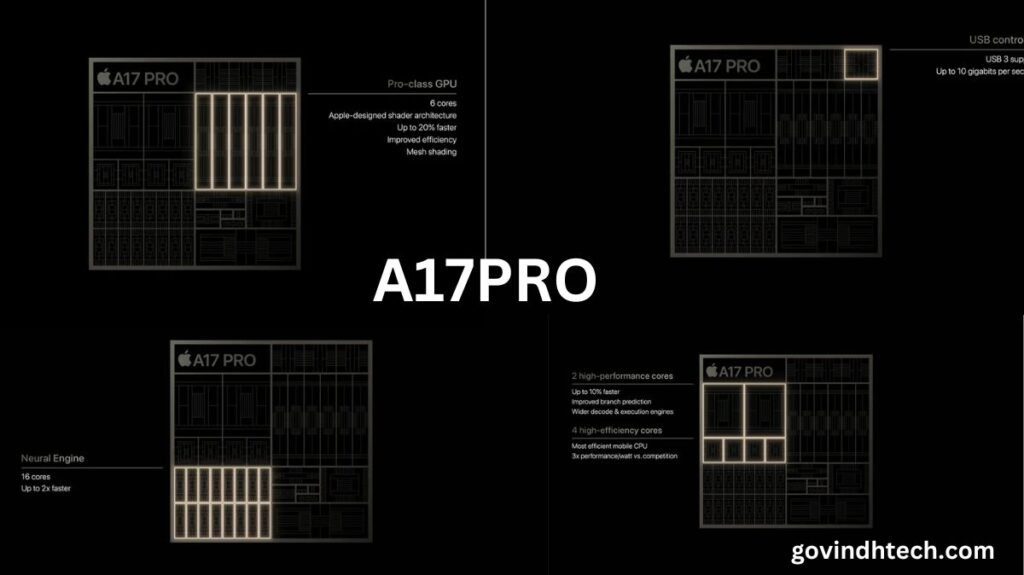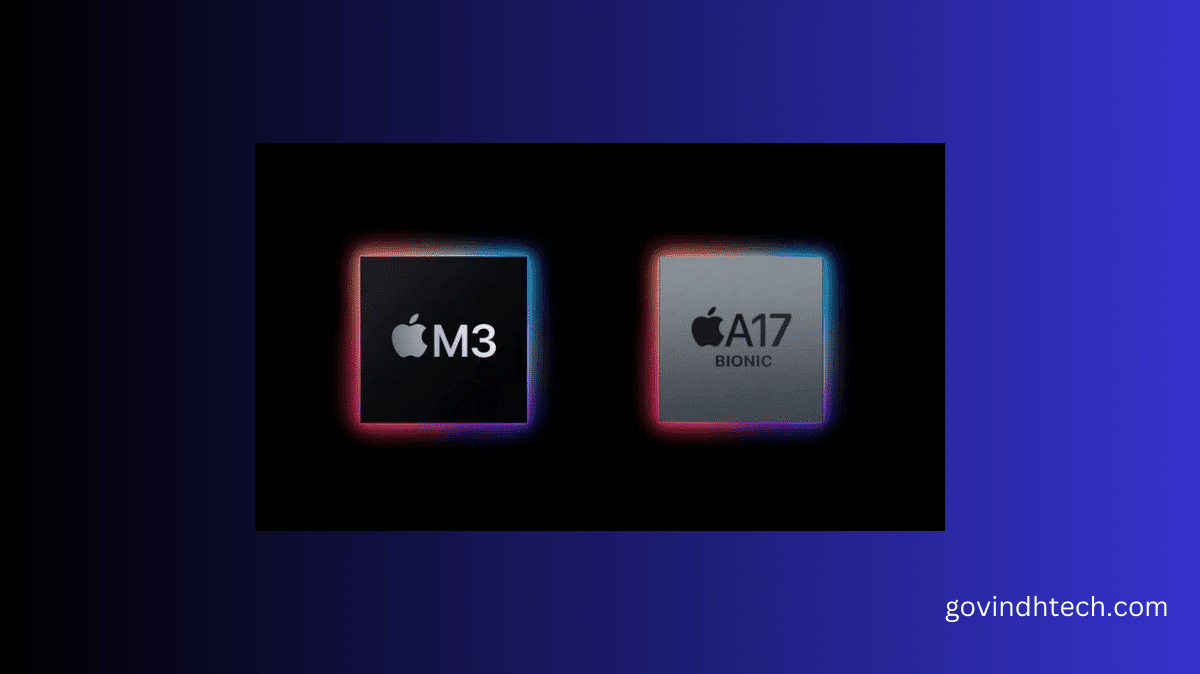Console-quality titles have been unveiled for the A17 Pro, which adds hardware ray tracing to a new GPU. Smartphone gaming is now possible thanks to Apple’s A17 Pro CPU.
The A17 Pro-Apple’s first 3-nanometer processor
The A17 Pro, Apple’s first 3-nanometer processor, will be used in the iPhone 15 Pro and iPhone 15 Pro Max. The A17 Pro includes a 6-core CPU with 19 billion transistors and two high-performance cores that are up to 10% quicker than its predecessors (Apple refers to this as a “faster mobile CPU”). It also has four high-efficiency cores.

Apple is convinced that it can handle even more operations at a faster rate than the 16-core Neural Engine’s maximum rate of 35 trillion per second. Additionally, the Pro Display Engine, an AV1 decoder, and specific ProRes engines exist.
The largest shift in Apple’s GPU history is the introduction of a new GPU with a bespoke shader architecture. It is up to 20% quicker than its predecessors and has six cores. The GPU makes hardware-accelerated ray tracing and mesh shading possible.
On the A16 Bionic, ray tracing is four times quicker than the software-based solution. Scalability is also possible when the GPU and neural engine cooperate. Apple has revealed that titles like Resident Evil Village and the Resident Evil 4 Remake will be coming to the iPhone 15 Pro and Pro Max because it views the GPU as a significant benefit for mobile gaming.
In the past, consoles and computers were the only platforms for these games. The Division: Resurgence and Genshin Impact were also introduced by Apple. Assassin’s Creed Mirage 2024, which had previously been revealed for console and PC, will now be available on the iPhone according to Ubisoft. The new GPU represents a significant advancement for the mobile gaming sector. It will enable game designers to make games on the iPhone 15 Pro and Pro Max that are even more powerful and realistic.
Additionally, the A17 Pro incorporates a USB 3 controller with a 10 Gbps maximum speed. It will thus operate more quickly than the USB Type-C connector, which takes the place of the Lightning port on non-Pro devices.
Apple suggests that customers will be able to easily transmit Pro footage to a Mac via USB 3 through the USB-C connector or record straight to an external storage device. 4K60 ProRes will also be supported. A second-generation ultra-wideband chip is also included in the A17 Pro for improved Find My accuracy or for sharing whereabouts with others.
Titanium Alloy 5 is the material used to create both the 6.1-inch iPhone 15 Pro and the 6.7-inch iPhone 15 Pro Max, which according to Apple makes them lighter than their forerunners. The phone has the smallest iPhone bezels ever seen, lowering overall size while preserving screen size. On the Pro versions, Apple substitutes a unique action button for the mute button that allows you to silence the phone if you’d like, open applications, turn on the camera, or utilize shortcuts.
| Apple A17 Pro | Apple A16 Bionic | |
| Transistors | 19 billion | 16 billion |
| CPU Cores | 6 (2 high-performance, 4 high-efficiency) | 6 (2 high-performance, 4 high-efficiency) |
| GPU Cores | 6 | 5 |
| Neural Cores | 16 | 16 |
| Neural engine operations per second | 35 trillion | 17 trillion |
A brand-new 48-megapixel primary camera with an f/1.78 aperture is available with the iPhone Pro. It can now shoot in 48-megapixel HEIF at 24mm, 28mm, and 35mm lens lengths. While the iPhone 15 Pro Max’s bigger size enables a 5x zoom (120mm focal length, f/2.8 aperture), the iPhone 15 Pro also has a new 12-megapixel 3x telephoto lens camera.
The telephoto lens’ sensor is twice as big as the one on the iPhone 14 Pro. A brand-new three-axis optical image stabilization with 10,000 micro corrections per second is also included in the iPhone 15 Pro Max (the iPhone 15 Pro has dual-axis image stabilization). A new 12-megapixel ultra-wide-angle camera with an enhanced night mode is also available (focal length 13 mm, aperture f/2.2).

Apple also revealed that 3D footage may be produced for Apple Vision Pro by combining the ultra-wide and primary cameras. Instead of debuting with the iPhone 15 Pro, this functionality will instead be made available later this year in an upgrade to iOS 17. However, there won’t be a 128GB variant available. The phones go up for pre-order on Friday and will be available on September 22.
The new A16 Bionic chip for the iPhone 15 and 15 Plus
The 6.1-inch or 6.7-inch iPhone 15 and iPhone 15 Plus have a similar look as the iPhone 14 and are available in pink, yellow, green, blue, or black. Dynamic Island, which was initially shown on the iPhone 14 Pro, is now present on the screens.
With the addition of a new 48-megapixel primary camera with a 26mm focal length and an aperture of f/1.6, the iPhone 15 has an entirely new camera system. Apple uses the A16 Bionic chip from the iPhone 14 Pro, which has a 5-core GPU, 4 efficiency cores, and 2 high-performance cores. The iPhone 15 can connect from farther away devices that utilize the same chip thanks to a brand-new second-generation ultra-wideband chip.
While MagSafe and Qi 2 are still possibilities, the new iPhones are the first to utilize USB-C for data transmission and charging. Additionally, the AirPods Pro Gen 2 will support USB-C, allowing you to use your iPhone to charge your AirPods or Apple Watch. Apple will also produce the EarPods in a USB-C variant.


[…] fact that Apple is moving away from the Lightning connector and toward the USB-C connection on all of the iPhone 15 […]
[…] it comes to the performance of a single core, the performance of the Apple A17 Pro System on Chip (SoC) is comparable to that of the Intel […]
[…] electric power use a low-cost mobile service provider […]
[…] CORSAIR HS35 v2 supports PC, console, and mobile gaming. You may enjoy high-quality music across many platforms with its universal compatibility, offering […]